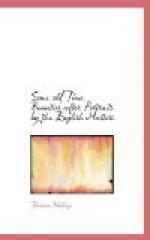This picture now hangs in the gallery of Stafford House, and was mezzotinted by Cousins, in 1844, and included in the published collection of the artist’s works. This volume is representative of the artist. It opens with that perennially delightful picture of the “Calmady Children,” called “Nature,”—one of the very best and sweetest representations of child life ever made. Here is the elemental artlessness of nature, and here the beatitude of innocence. Another child-picture is the portrait of Lady Emily Cowper, afterwards Lady Ashley, called “The Rosebud.” Among the ladies shown are Lady Leicester, Lady Lyndhurst, and Lady Georgiana Agar Ellis, the picture of the latter being surpassing in its elegance. That majestically maternal picture is here of Lady Gower and Lady Elizabeth Leveson Gower,—not our Elizabeth Mary, but she who became Duchess of Argyll.
The Countess of Grosvenor was a lady of high character and most affable manners, and held her exalted position with a dignity of demeanor and a bearing worthy of a descent from the noble Gowers, lords of Sittenham. Her residence latterly was Motcombe House, near Shaftesbury, Dorsetshire. She lived on until our own day, dying at the age of ninety-four.
In 1840-41 she accompanied her husband on a yacht voyage in the Mediterranean, an entertaining account of which she published in two volumes. She was a keen politician, as so many ladies of rank are in England. In 1873 Lady Westminster’s son, then Lord Robert Grosvenor, spoke in favor of the Liberal candidate for Shaftesbury. The candidate told her tenants that he believed her ladyship was not averse to his candidature. It was putting his fingers into the den of the apparently sleeping lioness. She wrote sharply: “I beg to undeceive you. I am most anxious for the success of the conservative cause, connected as it is with the preservation of our religion and our loyalty to our Queen.”



